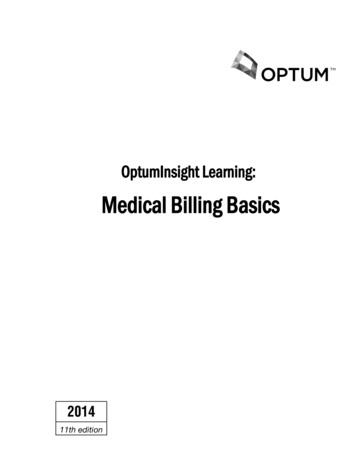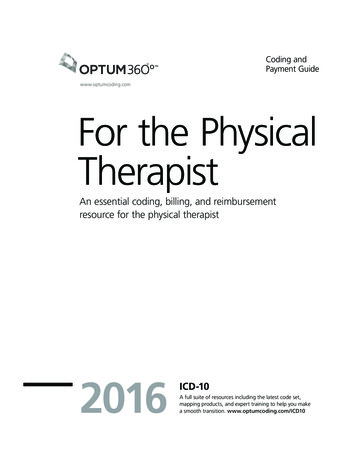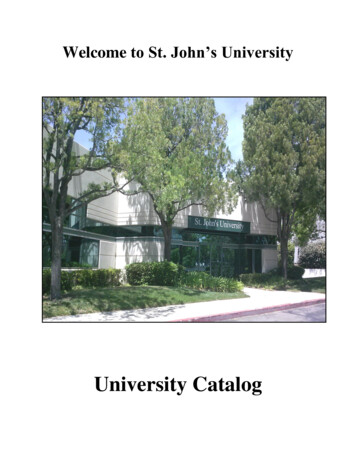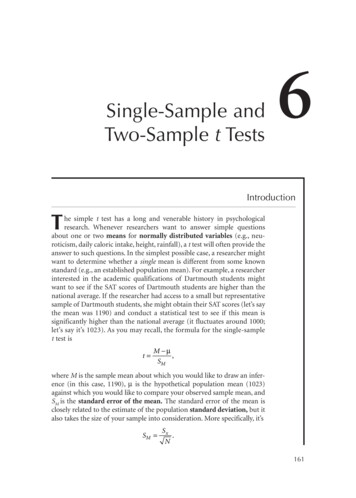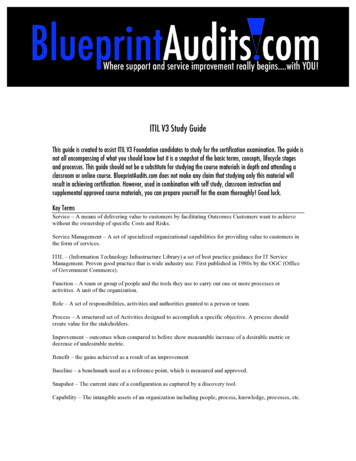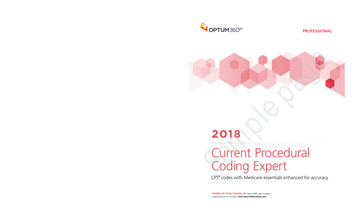
Transcription
ple2018201 8SamCurrent ProceduralCoding ExpertCEP CEP18 CVR.indd 1pagePROFESSIONALCurrent ProceduralCoding ExpertCPT codes with Medicare essentials enhanced for accuracyPOWER UP YOUR CODING with Optum360, your trustedcoding partner for 32 years. Visit optum360coding.com.12/18/16 3:35 PM
ContentsContentsSamplepAnatomical Illustrations . viiBody Planes and Movements viiIntegumentary System . viiiSkin and Subcutaneous Tissue . viiiNail Anatomy . viiiAssessment of Burn Surface Area . viiiMusculoskeletal System . ixBones and Joints . ixMuscles . xHead and Facial Bones . xiNose . xiShoulder (Anterior View) . xiShoulder (Posterior View) . xiShoulder Muscles . xiElbow (Anterior View) . xiiElbow (Posterior View) . xiiElbow Muscles . xiiElbow Joint . xiiLower Arm . xiiHand . xiiHip (Anterior View) . xiiiHip (Posterior View) . xiiiKnee (Anterior View) . xiiiKnee (Posterior View) . xiiiKnee Joint (Anterior View) . xiiiKnee Joint (Lateral View) . xiiiLower Leg . xivAnkle Ligament (Lateral View) . xivAnkle Ligament (Posterior View) . xivFoot Tendons . xivFoot Bones . xivRespiratory System . xvUpper Respiratory System . xvNasal Turbinates . xvParanasal Sinuses . xviLower Respiratory System . xviLung Segments . xviAlveoli . xviArterial System . xviiInternal Carotid and Arteries and Branches . xviiiExternal Carotid Arteries and Branches .xviiiUpper Extremity Arteries . xviiiLower Extremity Arteries . xviiiVenous System . xixHead and Neck Veins . xxUpper Extremity Veins . xxVenae Comitantes . xxVenous Blood Flow . xxAbdominal Veins . xxCardiovascular System . xxiCoronary Veins . xxiAnatomy of the Heart . xxiHeart Cross Section . xxiHeart Valves . xxiHeart Conduction System . xxiiCoronary Arteries . xxiiLymphatic System . xxiiiAxillary Lymph Nodes . xxivLymphatic Capillaries . xxivLymphatic System of Head and Neck . xxivLymphatic Drainage . xxivSpleen Internal Structures . xxvSpleen External Structures . xxvDigestive System . xxviGallbladder . xxviStomach . xxviMouth (Upper) . xxviiMouth (Lower) . xxviiPancreas . xxviiLiver . xxviiAnus . xxviiGenitourinary System . xxviiiUrinary System . xxviiiNephron . xxixMale Genitourinary . xxixTestis and Associate Structures . xxixMale Genitourinary System . xxixFemale Genitourinary . xxxFemale Reproductive System . xxxFemale Bladder . xxxFemale Breast . xxxEndocrine System . xxxiStructure of an Ovary . xxxiThyroid and Parathyroid Glands . xxxiiAdrenal Gland . xxxiiThyroid . xxxiiThymus . xxxiiNervous System . xxxiiiBrain . xxxivCranial Nerves . xxxivSpinal Cord and Spinal Nerves . xxxvNerve Cell . xxxviEye . xxxviiEye Structure .xxxviiPosterior Pole of Globe/Flow of Aqueous Humor . xxxviiEye Musculature . xxxviiEyelid Structures .xxxviiEar and Lacrimal System . xxxviiiEar Anatomy .xxxviiiLacrimal System . xxxviiiageIntroduction .iGetting Started with Current Procedural Coding ExpertProfessional Edition . iGeneral Conventions . iResequencing of CPT Codes . iCode Ranges for Medicare Billing . iiIcons . iiAppendixes . iv 2017 Optum360, LLCIndex . Index–1Tabular. 1Anesthesia . 1Integumentary. 15Musculoskeletal System.37Respiratory System .103Cardiovascular, Hemic, and Lymphatic .119Digestive System.169Urinary System .217Genital System.232Endocrine System .254Nervous System.257Eye, Ocular Adnexa, and Ear .285Radiology.303CPT 2017 American Medical Association. All Rights Reserved.1
ContentsCurrent Procedural Coding ExpertAppendix A — Modifiers .535CPT Modifiers . 535Modifiers Approved for Ambulatory Surgery Center (ASC)Hospital Outpatient Use . 537Appendix B — New, Changed and Deleted Codes .543New Codes . 543Changed Codes . 547Deleted Codes . 548Web Release New and Changed Codes . 548AMA Icon Only Changes . 549Appendix C: Evaluation and ManagementExtended Guidelines .551Appendix D — Crosswalk of Deleted Codes .569Appendix E — Resequenced Codes .571Appendix G — Medicare Internet-only Manuals (IOMs) . 583Medicare IOM references .583Appendix H — Physician Quality Reporting System (PQRS) . 685Appendix I — Medically Unlikely Edits (MUEs). 687Professional .687OPPS .711Appendix J — Inpatient Only Procedures . 735Appendix K — Place of Service and Type of Service . 747Appendix L — Multianalyte Assays with AlgorithmicAnalyses . 751Appendix M — Glossary . 753Appendix N — Listing of Sensory, Motor, andMixed Nerves . 767Motor Nerves Assigned to Codes 95900 and95907-95913 .767Sensory and Mixed Nerves Assigned to Codes95907–95913 .768SamplepAppendix F — Add-on Codes, Modifier 51 Exempt, OptumModifier 51 Exempt, Modifier 63 Exempt, and Modifier 95Telemedicine Services .581Add-on Codes . 581AMA Modifer 51 Exempt Codes .581Modifier 63 Exempt Codes .581Optum Modifier 51 Exempt Codes .581Telemedicine Services Codes .581ageContentsPathology and Laboratory. 339Medicine. 409Evaluation & Management. 477Category II Codes . 503Category III Codes . 5192CPT 2017 American Medical Association. All Rights Reserved. 2017 Optum360, LLC
Current Procedural Coding ExpertGenitourinary SystemageUrinary SystemSamplepAnatomical Illustrations—Genitourinary SystemAnatomical Illustrations—Genitourinary SystemxxviiiCPT 2017 American Medical Association. All Rights Reserved. 2017 Optum360, LLC
Urinary System5023022Nephrostomy without nephrostolithotomy (50040,50395, 52334)3 (76000, 76001)5 36.7 6 36.7 FUD 090Jmdc8AMA: 2016,Jan,13; 2015,Jan,16; 2014,Jan,11; 2012,Jan,15-42;2011,Jan,11Donor nephrectomy performed laparoscopically (50547)RetroperitonealAbscess drainage (49060)Exploration (49010)Tumor/cyst excision (49203-49205)50010Renal exploration, not necessitating other specificprocedures2 Laparoscopic ablation of mass lesions of kidney (50542)5 21.2 6 21.2 FUD 090Cdc8over 2 cm50100 Repair of Anomalous Vessels of the Kidney2AMA: 2014,Jan,11Retroperitoneal:Abscess drainage (49060)Exploration (49010)Tumor/cyst excision (49203-49205)50100Urinary System5008150010-50045 Kidney Procedures for Exploration or DrainageTransection or repositioning of aberrant renal vessels(separate procedure)5 30.5 6 30.5 FUD 090Cdc8ageAMA: 2016,Jan,13; 2015,Jan,16; 2014,Jan,1150120-50135 Procedures of Renal Pelvis2Retroperitoneal:Abscess drainage (49060)Exploration (49010)Tumor/cyst excision (49203-49205)50120Pyelotomy; with exploration1 Gol-Vernet pyelotomy2 Renal endoscopy through pyelotomy (50570-50580)5 27.2 6 27.2 FUD 090Cdc8AMA: 2016,Jan,13; 2015,Jan,16; 2014,Jan,115002050125Drainage of perirenal or renal abscess, open250040Nephrostomy, nephrotomy with drainage5 26.6 6 26.6 FUD 09050130with removal of calculus (pyelolithotomy, pelviolithotomy,including coagulum pyelolithotomy)5 29.6 6 29.6 FUD 090Cdc850135complicated (eg, secondary operation, congenital kidneyabnormality)5 32.7 6 32.7 FUD 090Cdc8AMA: 2016,Jan,13; 2015,Jan,16; 2014,Jan,11Cc8Nephrotomy, with explorationAMA: 2016,Jan,13; 2015,Jan,16; 2014,Jan,11mpl2 Renal endoscopy through nephrotomy (50570-50580)5 27.6 6 27.6 FUD 090C d c 8 50200-50205 Biopsy of Kidney2 Laparoscopic renal mass lesion ablation (50542)AMA: 2016,Jan,13; 2015,Jan,16; 2014,Jan,1150060-50081 Treatment of Kidney StonessCMS: 100-03,230.1 NCD for Treatment of Kidney Stones2 Retroperitoneal:Abscess drainage (49060)Exploration (49010)Tumor/cyst excision (49203-49205)50060Nephrolithotomy; removal of calculus5 32.8 6 32.8 FUD 090Cdc8Retroperitoneal tumor/cyst excision (49203-49205)502002 Fine needle aspiration (10022)3 (76942, 77002, 77012, 77021)4 (88172-88173)5 4.11 6 17.4 FUD 000secondary surgical operation for calculus5 34.7 6 34.7 FUD 090SaAMA: 2016,Jan,13; 2015,Jan,16; 2014,Jan,115007050205AMA: 2016,Jan,13; 2015,Jan,16; 2014,Jan,11removal of large staghorn calculus filling renal pelvis andcalyces (including anatrophic pyelolithotomy)5 41.9 6 41.9 FUD 090Cdc8AMA: 2016,Jan,13; 2015,Jan,16; 2014,Jan,1150080Percutaneous nephrostolithotomy or pyelostolithotomy,with or without dilation, endoscopy, lithotripsy, stenting, orbasket extraction; up to 2 cm2by surgical exposure of kidney5 21.8 6 21.8 FUD 090Cdc8AMA: 2016,Jan,13; 2015,Jan,16; 2014,Jan,11C d c 8 50220-50240 Nephrectomy Procedures2 Laparoscopic renal mass lesion ablation (50542)complicated by congenital kidney abnormality5 34.0 6 34.0 FUD 090Cdc850075Tgc8AMA: 2016,Jan,13; 2015,Jan,16; 2014,Jan,11AMA: 2016,Jan,13; 2015,Jan,16; 2014,Jan,1150065Renal biopsy; percutaneous, by trocar or needleNephrostomy without nephrostolithotomy (50040,50395, 52334)3 (76000, 76001)5 25.0 6 25.0 FUD 090Jmc8AMA: 2016,Jan,13; 2015,Jan,16; 2014,Jan,11; 2012,Jan,15-42;2011,Jan,11Retroperitoneal tumor/cyst excision (49203-49205)50220Nephrectomy, including partial ureterectomy, any openapproach including rib resection;5 30.1 6 30.1 FUD 090Cdc850225complicated because of previous surgery on samekidney5 34.6 6 34.6 FUD 090Cdc850230radical, with regional lymphadenectomy and/or vena cavalthrombectomyAMA: 2016,Jan,13; 2015,Jan,16; 2014,Jan,11AMA: 2016,Jan,13; 2015,Jan,16; 2014,Jan,112 Vena caval resection with reconstruction (37799)5 36.8 6 36.8 FUD 090Cdc8AMA: 2016,Jan,13; 2015,Jan,16; 2014,Jan,11# ResequencedUnlistedNot Coveredm Reinstatedl New Codes Revised Codel New Web Releases Revised Web Release, AMA Mod 51 Exempt B Optum Mod 51 Exempt L Mod 63 Exempt f Non-FDA Drug H Telehealth x Maternity y Age Edit Add-on AMA: CPT Asst 2017 Optum360, LLCCPT 2017 American Medical Association. All Rights Reserved.21750010 — 50230AMA: 2016,Jan,13; 2015,Jan,16; 2014,Jan,1150045Cdc8AMA: 2016,Jan,13; 2015,Jan,16; 2014,Jan,11epImage-guided percutaneous of perirenal or renalabscess (49405)5 29.2 6 29.2 FUD 090T8AMA: 2016,Jan,13; 2015,Jan,16; 2014,May,9; 2014,Jan,11;2013,Nov,9with drainage, pyelostomy5 29.6 6 29.6 FUD 090
Current Procedural Coding ExpertEvaluation and Management (E/M) Services GuidelinesClassification of Evaluation and Management(E/M) ServicesThe E/M section is divided into broad categories such as office visits,hospital visits, and consultations. Most of the categories are further dividedinto two or more subcategories of E/M services. For example, there are twosubcategories of office visits (new patient and established patient) andthere are two subcategories of hospital visits (initial and subsequent). Thesubcategories of E/M services are further classified into levels of E/Mservices that are identified by specific codes. This classification is importantbecause the nature of work varies by type of service, place of service, andthe patient’s status.The basic format of the levels of E/M services is the same for mostcategories. First, a unique code number is listed. Second, the place and/ortype of service is specified, eg, office consultation. Third, the content of theservice is defined, eg, comprehensive history and comprehensiveexamination. (See “Levels of E/M Services,” for details on the content of E/Mservices.) Fourth, the nature of the presenting problem(s) usuallyassociated with a given level is described. Fifth, the time typically requiredto provide the service is specified. (A detailed discussion of time is providedseparately.)Concurrent care is the provision of similar services (e.g., hospital visits) tothe same patient by more than one physician or other qualified health careprofessional on the same day. When concurrent care is provided, no specialreporting is required. Transfer of care is the process whereby a physician orother qualified health care professional who is managing some or all of apatient’s problems relinquishes this responsibility to another physician orother qualified health care professional who explicitly agrees to accept thisresponsibility and who, from the initial encounter, is not providingconsultative services. The physician or other qualified health careprofessional transferring care is then no longer providing care for theseproblems though he or she may continue providing care for otherconditions when appropriate. Consultation codes should not be reportedby the physician or other qualified health care professional who has agreedto accept transfer of care before an initial evaluation, but they areappropriate to report if the decision to accept transfer of care cannot bemade until after the initial consultation evaluation, regardless of site ofservice.ageIn addition to the information presented in the Introduction, several otheritems unique to this section are defined or identified here.Concurrent Care and Transfer of CareDecision Tree for New vs Established PatientsRecieved any professional service from thephysician or another physician in group ofsame specialty within last three yearsNOepYESDefinitions of Commonly Used TermsCertain key words and phrases are used throughout the E/M section. Thefollowing definitions are intended to reduce the potential for differinginterpretations and to increase the consistency of reporting by physiciansin differing specialties. E/M services may also be reported by other qualifiedhealth care professionals who are authorized to perform such serviceswithin the scope of their practice.New and Established PatientExact same specialtyYESmplSolely for the purposes of distinguishing between new and establishedpatients, professional services are those face-to-face services rendered byphysicians and other qualified health care professionals who may reportE/M services with a specific CPT code or codes. A new patient is one whohas not received any professional services from the physician/qualifiedhealth care professional or another physician/qualified health careprofessional of the exact same specialty and subspecialty who belongs tothe same group practice, within the past three years.An established patient is one who has received professional services fromthe physician/qualified health care professional or anotherphysician/qualified health care professional of the exact same specialtyand subspecialty who belongs to the same group practice, within the pastthree years. See the decision tree at right.SaWhen a physician/qualified health care professional is on call or coveringfor another physician/qualified health care professional, the patient’sencounter is classified as it would have been by the physician/qualifiedhealth care professional who is not available. When advanced practicenurses and physician assistants are working with physicians, they areconsidered as working in the exact same specialty and exact samesubspecialties as the physician.No distinction is made between new and established patients in theemergency department. E/M services in the emergency departmentcategory may be reported for any new or established patient who presentsfor treatment in the emergency department.Exact same subspecialtyYESNOEstablished patientNew patientNew patientNONew patientCounselingCounseling is a discussion with a patient and/or family concerning one ormore of the following areas: Diagnostic results, impressions, and/or recommended diagnosticstudies Prognosis Risks and benefits of management (treatment) options Instructions for management (treatment) and/or follow-up Importance of compliance with chosen management (treatment)options Risk factor reduction Patient and family education(For psychotherapy, see 90832–90834, 90836–90840)The decision tree in the next column is provided to aid in determiningwhether to report the E/M service provided as a new or an establishedpatient encounter.Family HistoryChief Complaint The health status or cause of death of parents, siblings, and childrenA chief complaint is a concise statement describing the symptom, problem,condition, diagnosis, or other factor that is the reason for the encounter,usually stated in the patient’s words. Specific diseases related to problems identified in the Chief Complaint or History of the Present Illness, and/or System Review 2017 Optum360, LLCA review of medical events in the patient’s family that includes significantinformation about:CPT 2017 American Medical Association. All Rights Reserved.477Evaluation and Management (E/M) Services GuidelinesEvaluation and Management (E/M)Services Guidelines
patients, professional services are those face-to-face services rendered by physicians and other qualified healt
